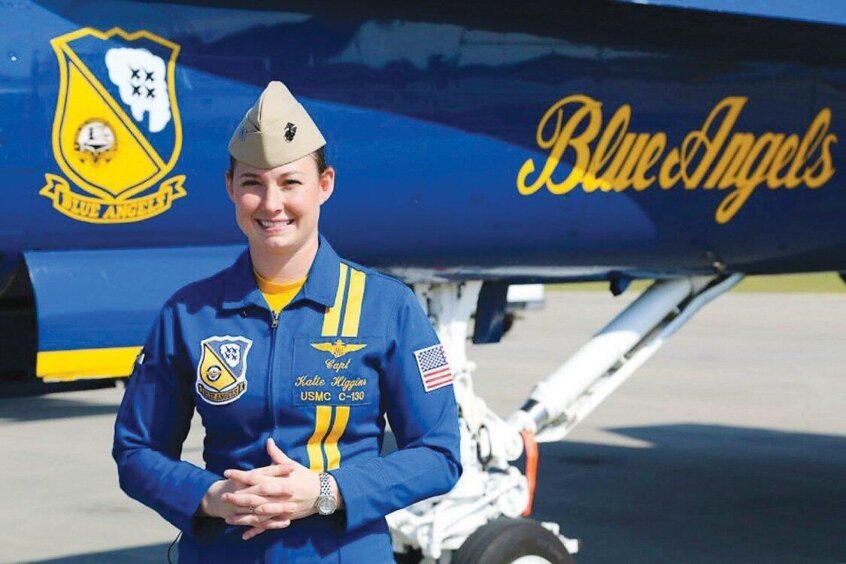Soaring Above: Female Blue Angels Pilots Breaking Barriers in Aviation | Female Blue Angels Pilots
In the exhilarating realm of aviation, where precision and skill reign supreme, a group of trailblazing women is rewriting the narrative of what it means to be a top-tier pilot. The U.S. Navy Blue Angels, renowned worldwide for their breathtaking aerial displays and unmatched expertise, have welcomed female pilots into their ranks, breaking barriers and inspiring a new generation of aviators. Notably, in 2014, Captain Katie Higgins made history as the first female pilot to join the Blue Angels, flying the iconic C-130 “Fat Albert.” More recently, in 2023, Lt. Amanda Lee soared into the spotlight as the first female jet pilot for the squadron, piloting the F/A-18 Super Hornet. These female Blue Angels pilots, with their unwavering determination and exceptional talent, are not just making history—they’re reshaping the future of aviation.
The Blue Angels: A Legacy of Precision and Pride
Since their formation in 1946, the U.S. Navy Blue Angels have captivated audiences with their daring maneuvers and synchronized performances. For decades, this elite squadron has showcased the skill and dedication of the Navy’s finest pilots. Occasionally, events like the Pt Mugu Air Show offer a chance to see both the Blue Angels and the Thunderbirds in action—weather permitting, of course. These performances highlight the pinnacle of aviation excellence, a standard that female now uphold with pride.
Breaking Barriers: The Rise of Female Blue Angels Pilots
Historically, the Blue Angels were an all-male team, mirroring the gender norms of the military and aviation industries. However, change began to take flight in 1973, when the first group of women—including trailblazers like Rosemary Mariner—started Navy pilot training at Pensacola. Fast forward to 2014, and Captain Katie Higgins became the first female pilot to join the Blue Angels, expertly flying the C-130 “Fat Albert.” Her achievement marked a turning point, proving women could excel in this prestigious squadron.
Then, in 2023, Lt. Amanda Lee broke yet another ceiling, becoming the first female jet pilot to fly the F/A-18 Super Hornet. Her milestone underscores the growing presence of women in aviation and the Navy’s commitment to diversity. Together, these female Blue Angels pilots have shattered stereotypes and opened doors for others to follow.
Inspiring the Next Generation of Aviators
Furthermore, For young women dreaming of flight, seeing soar at the highest levels is a game-changer. Specifically, Captain Higgins and Lt. Lee embody leadership, perseverance, and courage—qualities that challenge outdated stereotypes. Their stories resonate deeply, showing aspiring pilots that gender is no barrier to success. For example, programs supported by the Experimental Aircraft Association (EAA) now encourage girls to pursue aviation, inspired by these role models.
Overcoming Challenges with Grit and Grace
Becoming a Blue Angels pilot is no easy feat. pilots, like their male peers. Endure grueling training and must meet exacting standards. Beyond that, they often face unique hurdles—like skepticism or societal biases—rooted in aviation’s male-dominated past. Yet, their competence and resilience shine through. According to Lt. Amanda Lee in an AOPA interview, “The journey was tough, but every challenge made me stronger. so, I want other women to know they can do this too.” Such determination earns them respect worldwide.
Excellence in the Skies: A Legacy Beyond Gender
Importantly, the inclusion of female Blue Angels pilots isn’t just about diversity—it’s about excellence. However, These women showcase precision, teamwork, and skill that rival the best in aviation. Their contributions transcend gender, as noted by experts at FAA, who emphasize that talent drives success in the skies. As role models, they inspire future pilots to aim high, proving that hard work and passion can take anyone to the top.
A Future Without Limits
Looking ahead, the success of female Blue Angels pilots signals a brighter, more inclusive future for aviation. As more women enter the field, the industry gains diverse perspectives that fuel innovation,. A point echoed by NTSB safety studies. Their achievements—built on perseverance and skill—pave the way for a world where talent knows no bounds.
For more E3 Aviation resources, visit: https://e3aviationassociation.com
Keywords: Female Blue Angels Pilots, women in aviation, female pilots breaking barriers, diversity, aviation excellence

